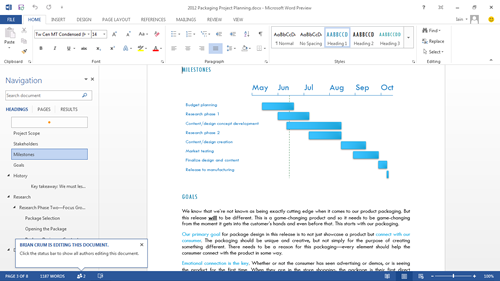Microsoft announced the details of Office 2013 on Monday. So what’s new?
It looks as you might expect like the Windows 8’s new Metro UI. Most of the translucent effects and gradients that were present in Office 2010’s Ribbon menus are replaced bysimple, flat fields in white and solid colors.The enhanced File menu, the “Backstage View” in Office 2010, is now like a full-fledged Metro app. that takes over the entire screen with a minimalistic, touch-friendly UI. When launched, each application presents a gallery of document styles with large, previews
This is a very touchy-feely build,: expansion/contraction pinch controls, swiping between functions within Office and for selecting fonts and type styles using rotary controls. A stylus can be integrated either to annotate documents or to act as a pointer during presentations. The ribbon is still there, but it’s hidden until the user touches or clicks on the menu system.
Some applications offer a “touch mode” button above the menu bar, to reconfigure the UI so that icons are farther apart andthe controls are larger, and easier to activate with touch screens. The overall UI doesn’t change much in touch mode for traditional desktop PCs, but it’s useful when a traditional keyboard and mouse aren’t available. (Applications that rely heavily on keyboard input, including Word and Excel, lack the touch mode).
Microsoft has made SharePoint more social-friendly. The new interface looks very like a social network site, and it will provide a news feed with threaded discussions, video, and shared applications, and suggest documents you might be interested in. Registered users get a “people car” that contains notes about them, an aggregation of all their social feeds, and ways to contact them via phone.
Skype is integrated directly with Office and the Phone 8 operating system so there’s little difference between VoIP and traditional telephony modes. (Yammer integration is also on the cards.)
Microsoft says this build is the smartest yet. In Excel, for example, the computer will suggest the best kind of charts and tables, and suggest automatic filling of cells based on past content.
Redmond also demoed a large-screen version of the new Office build on an 82-inch screen which comes from Microsoft’s recent Perceptive Pixel purchase. Redmond is pitching these as the perfect meeting tool, and one that can allow a style of collaborative working and on-screen videoconferencing that Ballmer said he hopes will stop people concentrating on pencil and paper.
![]()
Ballmer said he expects most people will use Office as a service rather than an installed base. No date was given for the final launch of Office 2013.



